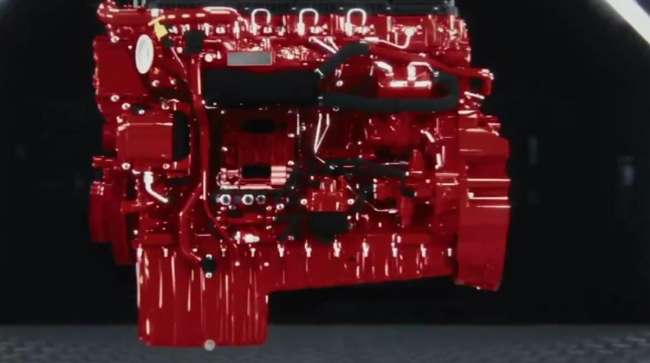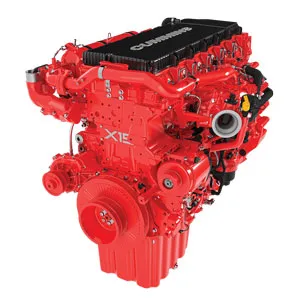Reducing Emissions Without Sacrificing Diesel Efficiency

[Stay on top of transportation news: Get TTNews in your inbox.]
For our industry, the year 2027 means meeting lower NOx standards while using less fuel.
Under old diesel design rules, this would be quite problematic because NOx forms at the high cylinder temperatures required for diesel efficiency. But, selective catalytic reduction technology can take care of NOx, leaving engineers free to build high-efficiency diesels with high peak cylinder pressures and temperatures while the aftertreatment systems can kill off the NOx. Turns out the superior aftertreatment system Cummins will use with its 2027 HELM version of the X15 takes major advantage of that principle.
SCR made NOx control simple until deteriorating road speeds, especially in populous states like California, killed its effectiveness because of the need to operate in crawling traffic. Cooler operation in those conditions shuts the system down since the reactions absorb energy rather than producing it. So unless the SCR gases and the catalyst are hot enough, the NOx-reducing chemical reactions just won’t happen. The 2027 NOx rules require that the SCR system work even when the truck is crawling, and that means keeping it hot all the time.
Why does the system cool at 15-20 mph? The lower engine load conditions that pertain at a crawl cause fueling to drop off significantly while air flow drops only marginally because, as you know, diesels have no throttle. When a rig is running at 15-20 mph in heavy traffic instead of at 65-70, the SCR system cools so much that the NOx flows right through without reacting with the diesel exhaust fluid.

Baxter
Cummins’ solution to the problem, according to Mark Ulrich, director of customer support, will involve no extensive architectural changes. The new engine will have common-rail injection, a variable-geometry turbocharger, and jacket water-cooled exhaust gas recirculation. But the aftertreatment system will be slightly larger and it will incorporate two electric heaters and two diesel exhaust fluid dosers.
The heaters will be powered by a belt-driven, 48-volt alternator that powers only the emission system heaters. The high voltage means lower amperage in the alternator, maximizing its efficiency as well as the gauge of necessary wiring. One heater and doser will precede the Diesel Oxidation Catalyst that sits at the front of the diesel particulate filter, utilizing this catalyst to start the NOx reduction process, and the second such combination of components will sit at the intake of the SCR catalyst. The two heaters will ensure continual, peak NOx reduction no matter how low engine loads may go. The 48-volt system will generate the necessary heat at maximum efficiency (thus having minimal effect on fuel economy) and with simple components that weigh very little.

A rendering of Cummins’ EPA- and CARB 2027-compliant HELM X15 diesel engine. (Cummins Inc.)
In spite of a somewhat heavier emission control system, the overall engine package will be no heavier than the present product. This is possible because the HELM block is a fresh design. While the same basic material — gray iron — will provide the structure of both the block and head, both Ulrich and Jared Holcomb, on-highway product manager, touted the extensive use of the most advanced design tools for laying out the new block and head. Detailed analysis of engine stresses and block design can ensure material is placed only exactly where needed to handle operating stress. This minimizes weight while avoiding any compromise in strength. Optimizing the configuration of block and head also helps the structure to attenuate noise.
The camshaft drive has been moved to the rear of the block. This eliminates the bolted-on front gear housing used on the present design, and it also greatly reduces noise and vibration that results from the geartrain that drives the valve system. Placing the camshaft drive gearing at the rear end of the engine uses the flywheel’s mass to greatly reduce the amplitude of crankshaft vibrations, meaning a much quieter geartrain. Another major enhancement is the use of dual overhead camshafts — one to drive the intake valves, and the other for the exhausts.
We're entering a new era. pic.twitter.com/ocr7Mg2OgE — Cummins Inc. (@Cummins) July 31, 2024
This means less mass (a much shorter rocker lever) between the camshaft and each valve, allowing sharper response — more rapid opening and closing valve actions. The result is improved breathing, a significant way to reduce engine parasitic loads and optimize emissions, engine performance and fuel economy. While the new engine’s valve-operating system is simple right now, provision for variable valve timing has been designed in, in case such an enhancement will be required in the future. There will be no change in the overhead setting requirement, which is already set at an unusually long 500,000 miles.
The performance of the XPI fuel system has been enhanced, the available operating pressure having been increased to 2,400 bar (34,809 psi). Enhancements to piston bowl design and the optimization of the combustion system will further enhance fuel economy.
McLeod Software CEO Tom McLeod explores the potential for artificial intelligence to boost efficiency and build resilience. Tune in above or by going to RoadSigns.ttnews.com.
The new architecture will also include cartridge-type oil and fuel filters, a design that significantly reduces filter disposal volume and costs and is considered to be environmentally friendlier than spin-on type filtration. Customers seem to like the change, says Holcomb.
While no significant changes to oil and coolant intervals are contemplated, Ulrich reports that Cummins OilGuard will continue to be available so customers can optimize change intervals based on the specifics of their trucks’ duty cycles.
The new design will be a 2027 product. In spite of all the changes in the emission system and block and head design, the engine families and ratings will remain quite similar to the present lineup, in many cases with identical power and torque numbers.
One of the most important benefits of the redesign echoes 2010, when SCR allowed diesels to use significantly less fuel. The new SCR system is so efficient and so consistent at providing peak NOx-reduction performance that it allows the engine to be tuned for higher efficiency. This means somewhat higher cylinder temperatures and pressures, a key to fuel efficiency. Even though the package meets the very low 2027 NOx standard, it will do so with only a very small increase in DEF consumption. The overall result should be a low total cost of operation.
Want more news? Listen to today's daily briefing below or go here for more info:





